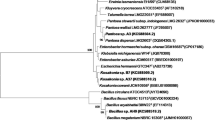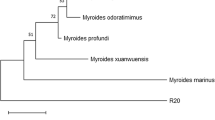Abstract
The study was conducted for evaluation of the effect of microbial consortia for growth attributes and protein content of micropropagated plants of Bacopa monnieri. Five microbial strains e.g., Pseudomonas sp. BHUPSB04, Pseudomonas sp. BHUPSB06, Burkholderia sp. BHUPSB03, Bacillus sp. BHUPSB13 and Paenibacillus sp. BHUPSB16 were isolated and characterised on the basis of biochemical and molecular characters. Burkholderia sp. BHUPSB03 was screened as an effective and significant for phosphate solubilisation, production of indole-3-acetic acid, ammonia, hydrogen cyanide and siderophores. Hydrogen cyanide was produced by other strains namely Bacillus sp. BHUPSB13, Paenibacillus sp. BHUPSB16 and Pseudomonas sp. BHUPSB04. Higher indole-3-acetic acid production was recorded with Burkholderia sp. BHUPSB03 followed by Bacillus sp. BHUPSB13, Pseudomonas sp. BHUPSB04 and Pseudomonas sp. BHUPSB06 as compared to A. Brasilense and T. harzianum. Tetra inoculation of microbial consortia Azospirillum + Pseudomonas sp. BHUPSB06 + Trichoderma + Burkholderia sp. BHUPSB03 showed maximum growth attributes like shoot length, number of branching, dry weight and protein content in micropropagated plants of B. monnieri followed by tri-inoculation of A. brasilense + Pseudomonas sp. BHUPSB06 with Burkholderia sp. BHUPSB03/Pseudomonas sp. BHUPSB04/Paenibacillus sp. BHUPSB16/Bacillus sp. BHUPSB13 as compared to control and other treatments. Therefore, tetra and tri inoculations may be used as most efficient microbial consortia for enhancing the growth attributes and protein content in shoots of B. monnieri.


Similar content being viewed by others
References
Rastogi S, Pal R, Kulshreshtha DK (1994) Bacoside A3, a triterpenoid saponins from Bacopa monnierai. Phytochemistry 36:133–137
Singh HK, Dhawan B (1997) Neuropsychopharmacological effects of the ayurvedic nootropic Bacopa monnieri Linn. (Brahmi). Indian J Pharm 29:359–365
Rauf K, Subhan F, Sewell RD (2012) A bacoside containing Bacopa monnieri extract reduces both morphine hyperactivity plus the elevated striatal dopamine and serotonin turnover. Phytoth Res 26:758–763. doi:10.1002/ptr.3631
Ghosh T, Maity TK, Singh J (2011) Evaluation of antitumor activity of stigmasterol, a constituent isolated from Bacopa monnieri Linn aerial parts against Ehrlich Ascites Carcinoma in mice. Orien Pharm Experi Medi 11(1):41–49
Bhakuni DS, Dhar ML, Dhar MM, Dhawan BN, Mehrotra BN (1969) Screening of Indian plants for biological activity. Ind J Exp Biol 7:250–262
Singh R, Tiwari S, Soni SK, Singh D, Singh R, Singh SP, Kumar PVA, Pandey R, Kalra A (2014) Bioinoculants as a tool to improve total bacoside content in Bacopa monnieri L. (Pennell). International J Sci Engi Res 5(1):878–896
Sairam K, Dorababu M, Goel RK, Bhattacharya SK (2002) Antidepressant activity of standardized extract of Bacopa monniera in experimental models of depression in rats. Phytomedicine 9:207–211
Shanmugasundaram ER, Akbar GK, Shanmugasundaram KR (1991) Brahmighritham, an Ayurvedic herbal formula for the control of epilepsy. J Ethnopharmacol 33:269–276
Paulose CS, Chathu F, Khan SR, Krishnakumar A (2008) Neuroprotective role of Bacopa monnieri extract in epilepsy and effect of glucose supplementation during hypoxia: glutamate receptor gene expression. Neurochem Res 33:1663–1671
Uabundit N, Wattanathorn J, Mucimapura S, Ingkaninan K (2010) Cognitive enhancement and neuroprotective effects of Bacopa monnieri in Alzheimer’s disease model. J Ethnopharmacol 127:26–31
Tiwari V, Tiwari K, Singh BD (2001) Comparative studies of cytokinins on in vitro propagation of Bacopa monniera. Plant Cell, Tissue Organ Cult 66:9–16
Westover KM, Kennedy AC, Kelly SE (1997) Patterns of rhizosphere microbial community structure associated with co-occurring plant species. J Ecology 85:863–873
Kloepper JW, Schroth MN (1978) Plant growth-promoting rhizobacteria on radishes, In: Angers DA (ed) Proceeding of the fourth international conference on plant pathogen bacteria 2, pp. 879–882
Ahmad F, Ahmad I, Khan MS (2008) Screening of free-living rhizospheric bacteria for their multiple plant growth promoting activities. Microbiol Res 163:173–181
Singh R, Soni SK, Patel RP, Kalra A (2013) Technology for improving essential oil yield of Ocimum basilicum L. (sweet basil) by application of bioinoculant colonized seeds under organic field conditions. Ind Crops Prod 45:335–342
Awasthi A, Bharti N, Nair P, Singh R, Shukla AK, Gupta MM, Darokar MP, Kalra A (2011) Synergistic effect of Glomusmosseae and nitrogen fixing Bacillus subtilis strain Daz26 on artemisin in content in Artemisia annua L. Appl Soil Ecol 49:125–130
Satheesan J, Narayanan AK, Sakunthala M (2012) Induction of root colonization by Piriformospora indica leads to enhanced asiaticoside production in Centella asiatica. Mycorrh 22:195–202
Kennedy AC, Smith KL (1995) Soil microbial diversity and the sustainability of agricultural soils. Plant Soil 170:75–86
USDA (1988) Soil taxomony: a basic system of soil classification for making and interpreting soil surveys. U.S. Department of Agriculture, Washington
Aneja KR (2003) Experiments in microbiology, plant pathology and biotechnology, 4th edn. New Age International Publishers Daryaganj, New Delhi
Cappuccino JC, Sherman N (1992) Microbiology: a laboratory manual, 3rd edn. Benjamin/Cummings Publication Co., New York, pp 125–179
Dan-Ping M, Zhou Q, Chong-Yu Chen, Zhe-Xue Q (2012) Coverage evaluation of universal bacterial primers using the metagenomic datasets. BMC Microbiol 12:66
Bric JM, Bostock RM, Silverstone SE (1991) Rapid in situ assay for indole acetic acid production by bacteria immobilized on nitrocellulose membrane. Appl Environ Microbiol 57:535–538
Pikovskaya RI (1948) Mobilization of phosphorus in soil in connection with the vital activity of some microbial species. Microbiol 17:362–370
Westover KM, Kennedy AC, Kelly SE (1997) Patterns of rhizosphere microbial community structure associated with co-occurring plant species. J Ecology 85:863–873
Schwyn B, Neilands JB (1987) Universal chemical assay for the detection and determination of siderophores. Anal Biochem 160:47–56
Jha BK, Pragash MG, Cletus J, Raman G, Sakthivel N (2009) Simultaneous phosphate solubilization potential and antifungal activity of new fluorescent pseudomonad strains, Pseudomonas aeruginosa, P. plecoglossicida and P. mosselii. World J Microbiol Biotechnol 25:573–581
Tiwari V, Singh BD, Tiwari KN (1998) Shoot regeneration and somatic embryogenesis from different explants of Brahmi (Bacopa monniera). Plant cell report 17:538–543
Bradford MM (1979) A rapid and sensitive for the quantitation of microgram quantitites of protein utilizing the principle of protein-dye binding. Anal Biochem 72:248–254. doi:10.1016/0003-2697(76)90527-3
Holt JG, Krieg NR, Sneath PHA, Staley JT, Williams ST (1994) Bergy’s manual of determinative bacteriology, 9th edn. Williams and Wilkins Pub, MD
Devi SI, Somkuwar B, Potshangbam M, Talukdar NC (2012) Genetic characterization of Burkholderia cepacia strain from Northeast India: a potential bio-control agent. Adv Biosci Biotech 3:1179–1188
Ramani V, Patel HH (2011) Phosphate solubilization by Bacillus sphaericus and Burkholderia cepacia in presence of pesticides. J Agri Technol 7(5):1331–1337
Rodriguez H, Fraga R, Gonzalez T, Bashan Y (2006) Genetics of phosphate solubilisation and its potential applications for improving plant growth-promoting bacteria. Plant Soil 287:15–21
Fatima Z, Saleemi M, Zia M, Sultan T, Aslam M, Riaz-ur-Rehman Chaudhary MF (2009) Antifungal activity of plant growth-promoting rhizobacteria isolates against Rhizoctonia solani in wheat. Afr J Biotechnol 8:219–225
Sekar S, Kandavel D (2010) Interaction of plant growth promoting rhizobacteria (PGPR) and endophytes with medicinal plants–new avenues for phytochemicals. J Phytol 2(7):91–100
Bharti N, Yadav D, Barnawal D, Maji D, Kalra A (2013) Exiguobacterium oxidotolerans, a halotolerant plant growth promoting rhizobacteria, improves yield and content of secondary metabolites in Bacopa monnieri (L.) Pennell under primary and secondary salt stress. World J Microbiol Biotechnol 29:379–387
Acknowledgments
Authors are thankful to Head, Department of Soil Science and Agricultural Chemistry for providing Plant Growth Chamber for conducting this experiment in soil microbiology laboratory. Fund was provided for this study to Prof. Janardan Yadav from Centre of Organic Farming Centre Ghaziabad, Ministry of Agriculture, Government of India.
Author information
Authors and Affiliations
Corresponding author
Rights and permissions
About this article
Cite this article
Verma, J.P., Tiwari, K.N., Yadav, J. et al. Development of Microbial Consortia for Growth Attributes and Protein Content in Micropropagated Bacopa monnieri (L.). Proc. Natl. Acad. Sci., India, Sect. B Biol. Sci. 88, 143–151 (2018). https://doi.org/10.1007/s40011-016-0743-x
Received:
Revised:
Accepted:
Published:
Issue Date:
DOI: https://doi.org/10.1007/s40011-016-0743-x




